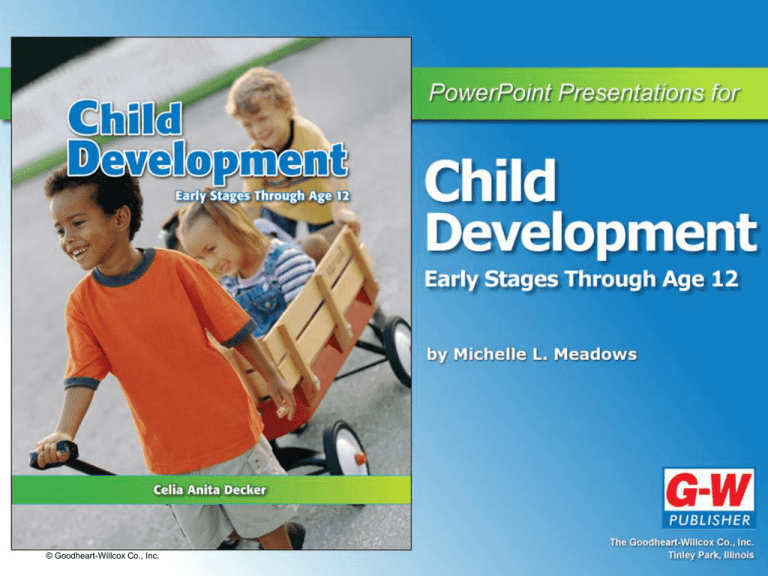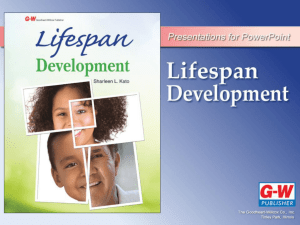Chapter 1 - Goodheart
advertisement

© Goodheart-Willcox Co., Inc. 1 Learning About Children © Goodheart-Willcox Co., Inc. Key Terms • child-centered society • socialize • culture • character • development • child development • individual life cycle © Goodheart-Willcox Co., Inc. • • • • • • • • heredity environment genes genetics neurons wiring axons dendrites continued Key Terms • synapse • pruning • window of opportunity • plasticity • developmental acceleration • developmental delay © Goodheart-Willcox Co., Inc. • principles of growth and development • sequenced steps • teachable moment • developmental tasks • direct observation • indirect observation Objective • List reasons for learning about children. © Goodheart-Willcox Co., Inc. Why Study Children? • Understand yourself • Be a responsible parent • Protect children’s rights • Work with children © Goodheart-Willcox Co., Inc. Children Need Safe Environments • Homes and schools that promote health and well-being • A child-centered society – sees children as important – cares about their well-being – works to meet their needs © Goodheart-Willcox Co., Inc. To Be a Responsible Parent • Physical needs – food, clothing, shelter – physical protection – proper health and medical care • Intellectual needs – positive learning experiences © Goodheart-Willcox Co., Inc. continued To Be a Responsible Parent • Social needs – socialize children – teach children about their culture – help children develop character • Trust needs • Love and guidance needs © Goodheart-Willcox Co., Inc. Children’s Rights • An identity • A family • Express themselves and have access to information • A safe, healthy life • Special protection in times of war • An education © Goodheart-Willcox Co., Inc. • Special care for the disabled • Protection from discrimination • Protection from abuse • Protection from harmful work • Special treatment if arrested Objective • Define the term child development. © Goodheart-Willcox Co., Inc. What Is Child Development? • Development is the gradual process through which babies become adults • Child development is the scientific study of children from conception to adolescence • The individual life cycle is a description of the stages of change people experience throughout life © Goodheart-Willcox Co., Inc. Objective • Summarize the six stages of the individual life cycle that involve children. © Goodheart-Willcox Co., Inc. Individual Life Cycle— Childhood Stages • Prenatal stage: conception to birth • Neonatal stage: birth through the second week • Infancy stage: two weeks through the first birthday • Toddler stage: 12–36 months • Preschool stage: 3–6 years • School-age stage: 6–12 years © Goodheart-Willcox Co., Inc. Objective • Describe three factors that promote growth and development. © Goodheart-Willcox Co., Inc. Factors That Influence Growth and Development © Goodheart-Willcox Co., Inc. Heredity • Heredity includes traits passed to a child from blood relatives • Genes are sections of the DNA molecule – found in cells – determine traits • Genetics is the study of heredity © Goodheart-Willcox Co., Inc. continued Heredity • The genes’ instructions are lifelong • Genes affect some parts of growth and development more than others • Some genes determine whether a person will have a trait • Other genes affect the range of a trait © Goodheart-Willcox Co., Inc. Environment • Physical conditions are part of the environment – food, rest • Environments shape experiences • Relationships with others are part of the environment • Environments affect physical, intellectual, and social-emotional traits © Goodheart-Willcox Co., Inc. Heredity and Environment Combined • Genes and the environment work together © Goodheart-Willcox Co., Inc. Objective • Explain how brain development occurs. © Goodheart-Willcox Co., Inc. Basic Wiring • Neurons are brain cells that direct various tasks of the brain • Wiring is a network of fibers that carry signals between neurons • Axons are cables that transmit signals from a neuron to other neurons © Goodheart-Willcox Co., Inc. continued Basic Wiring • Dendrites are cables that allow each neuron to receive signals sent by other neurons • Synapse is a gap between neurons across which electrical impulses can be transmitted © Goodheart-Willcox Co., Inc. Heredity and Environment Interact • Heredity and environment work together to develop the brain • Rich sensory experiences enhance brain development – create new dendrites • Pruning is the process in which the brain weeds out unused pathways © Goodheart-Willcox Co., Inc. Windows of Opportunity • Genes control the order and timetable of brain development • Each region of the brain has a specific function – develop at various rates • Windows of opportunity occur – prime period for developing a specific skill – may overlap © Goodheart-Willcox Co., Inc. Brain Plasticity • Plasticity lessens with age – early years are crucial • Plasticity can have positive and negative effects on brain development © Goodheart-Willcox Co., Inc. continued Brain Plasticity • Interaction with loving adults engaged in daily tasks and familytype activities • Choices in what and how to learn • Time to practice and master skills © Goodheart-Willcox Co., Inc. continued Brain Plasticity • The infant and toddler years are times of great brain activity and learning • Some children need early professional intervention to overcome obstacles to healthy brain development • Good early environments provide the best foundation for development and promote resiliency © Goodheart-Willcox Co., Inc. What Do You Think? • Do you think most families know what best supports brain development in young children? Why or why not? • Do academic exercises, such as computer programs for infant learning, support brain development in young children? Why or why not? © Goodheart-Willcox Co., Inc. Objective • Identify differences in the rate of growth and development. © Goodheart-Willcox Co., Inc. Differences in the Rate of Growth and Development • Growth and development occurs in expected sequences – stages • Children enter and leave stages at different rates – developmental acceleration – developmental delay © Goodheart-Willcox Co., Inc. continued Differences in the Rate of Growth and Development • Children do not advance in all areas at the same rate • Children may be accelerated or delayed in one or more areas • Children may be accelerated in one area and delayed in another © Goodheart-Willcox Co., Inc. Objective • Explain and give examples of some major principles and theories of growth and development. © Goodheart-Willcox Co., Inc. Principles of Growth and Development • Principles of growth and development do not fit every person exactly • Key principles – constant – gradual and continuous – sequenced steps – different rates – interrelated © Goodheart-Willcox Co., Inc. Growth and Development Are Constant • Many aspects of growth and development are unchanging – constancy • Traits controlled by heredity do not change • People often live in the same environment for many years © Goodheart-Willcox Co., Inc. Growth and Development Are Gradual and Continuous • Changes happen in little, unbroken steps • Positive aspects – development does not reverse overnight – if development is delayed, may occur later in life © Goodheart-Willcox Co., Inc. continued Growth and Development Are Gradual and Continuous • Negative aspects – poor growth and development are not easily reversed – a delay because of environmental issues may need intervention © Goodheart-Willcox Co., Inc. Growth and Development Happen in Sequenced Steps • Change must build on what children have already learned • Steps in growth and development follow one another in sequenced steps © Goodheart-Willcox Co., Inc. continued Growth and Development Happen in Sequenced Steps • A teachable moment occurs when – the body and mind are physically ready – caregivers offer encouragement – the child feels a strong desire to learn • Children feel stressed if pushed to learn before the teachable moment • Waiting too long after a teachable moment may cause problems © Goodheart-Willcox Co., Inc. Growth and Development Happen at Different Rates • Both fast and slow periods of growth and development occur – intense growth in infancy, slower in middle school • Rates of growth and development vary from one child to another – sequence is similar – differ due to heredity, environment, and motivation © Goodheart-Willcox Co., Inc. continued Growth and Development Happen at Different Rates • Heredity determines different growth rates • Children need a good environment to grow at the best rate – lags may occur if environment is lacking – hurrying a child may cause stress • Some children are more motivated to grow and achieve than others © Goodheart-Willcox Co., Inc. Growth and Development Are Interrelated • All aspects of growth and development interact in complex ways © Goodheart-Willcox Co., Inc. Theories of Growth and Development • • • • • Erik Erikson (1902–1994) Jean Piaget (1896–1980) Lev Vygotsky (1896–1934) Robert J. Havighurst (1900–1991) Abraham Maslow (1908–1970) © Goodheart-Willcox Co., Inc. Havighurst’s Theory of Developmental Tasks • Mastery of skills and activities that fit level of growth and development • Failure to achieve developmental tasks leads to unhappiness and problems with later tasks © Goodheart-Willcox Co., Inc. continued Havighurst’s Theory of Developmental Tasks • Developmental tasks come from three sources – physical growth – social pressures – inner pressures © Goodheart-Willcox Co., Inc. Maslow’s Hierarchy of Human Needs • Development is a result of meeting personal needs • People work to fulfill basic needs and higher-level needs • Lower-level needs must be met before higher-level needs can be pursued © Goodheart-Willcox Co., Inc. continued Maslow’s Hierarchy of Human Needs • Physical needs – air, water, food, clothing, shelter • Security – need to feel safe in surroundings • Love and acceptance – need for support, assurance, praise, acceptance • Esteem – need to be liked and accepted © Goodheart-Willcox Co., Inc. continued Maslow’s Hierarchy of Human Needs • Selfactualization – all needs have been fulfilled to some degree © Goodheart-Willcox Co., Inc. Objective • Develop observation skills. © Goodheart-Willcox Co., Inc. Observing Children • Observation is the oldest, most common, and best way to learn about human behavior • Observing adults who work with children provide a model • Many observational skills are learned © Goodheart-Willcox Co., Inc. Why Observe Children? © Goodheart-Willcox Co., Inc. Ways to Observe • Direct observation means watching children in natural environments • Indirect observation includes gathering information about children from various sources – questioning parents, teachers, children – examining children’s products, such as artwork or writings © Goodheart-Willcox Co., Inc. Guidelines for Observing • • • • • • • • Know your objectives Obtain permission to observe Know what to do at the site Ask questions at convenient times Do not distract children from activities Observe carefully and objectively Record accurately Protect the rights of all observed © Goodheart-Willcox Co., Inc. continued Guidelines for Observing • Protect rights – subject – observer • List behaviors to follow • Help make observations meaningful © Goodheart-Willcox Co., Inc. What Would You Do? • You are working in a child care facility caring for 10 five-year-olds • One child cries every day when transitioning from free play to lunch How could you use observation to address this problem? © Goodheart-Willcox Co., Inc. Glossary of Key Terms • axons. Long, thick cables that transmit all the signals from a neuron to other neurons. • character. Principles and beliefs that guide one’s conduct and define one’s personality and behavior. • child-centered society. Society that sees children as important, cares about their well-being, and works to meet their needs. © Goodheart-Willcox Co., Inc. Glossary of Key Terms • child development. Scientific study of children from conception to adolescence. • culture. Way of life within a group that includes language, beliefs, attitudes, values, rituals, and skills. • dendrites. Short, bushy cables that allow each neuron to receive signals sent by other neurons. © Goodheart-Willcox Co., Inc. Glossary of Key Terms • development. Gradual process of growth through many stages, such as before birth, infancy, childhood, adolescence, and adulthood. • developmental acceleration. When a child performs like an older child. • developmental delay. When a child performs like a younger child. © Goodheart-Willcox Co., Inc. Glossary of Key Terms • developmental tasks. Skills that should be mastered at a certain stage in life. • direct observation. Watching children in their natural environments. • environment. Sum of all the conditions and situations that surround and affect a child’s growth and development. © Goodheart-Willcox Co., Inc. Glossary of Key Terms • genes. Sections of the DNA molecule found in a person’s cells that determine the individual traits the person will have. • genetics. Study of the factors involved in the passing of traits from one generation of living beings to the next. • heredity. Sum of all the traits that are passed to a child from blood relatives. © Goodheart-Willcox Co., Inc. Glossary of Key Terms • indirect observation. Observation done by methods other than watching children, including asking other people questions about the children and observing the products children make. • individual life cycle. Description of the stages of change people experience throughout life. © Goodheart-Willcox Co., Inc. Glossary of Key Terms • neurons. Brain cells that send and receive electrical impulses amongst each other to direct the various tasks of the brain. • plasticity. Ability of the brain to be shaped and reshaped, which is greatest early in life. • principles of growth and development. Statements of the general patterns in which growth and development take place in people. © Goodheart-Willcox Co., Inc. Glossary of Key Terms • pruning. Process of weeding out underused or weak pathways between neurons. • sequenced steps. Steps in growth and development that follow one another in a set order. • socialize. To train a child to live as part of a group, such as the family, culture, or society. © Goodheart-Willcox Co., Inc. Glossary of Key Terms • synapse. Tiny gap between a dendrite of one neuron and the axon of another across which electrical impulses can be transmitted. • teachable moment. Time when a person can learn a new task because the body is physically ready, caregivers encourage and support, and the child feels a strong desire to learn. © Goodheart-Willcox Co., Inc. Glossary of Key Terms • window of opportunity. Prime period in a child’s life for developing a particular skill if given the opportunity. • wiring. Network of fibers that carry brain signals between neurons. © Goodheart-Willcox Co., Inc.








